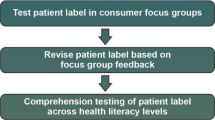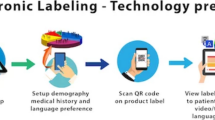Abstract
BACKGROUND
Medication guides are required documents to be distributed to patients in order to convey serious risks associated with certain prescribed medicines. Little is known about the effectiveness of this information to adequately inform patients on safe use.
OBJECTIVE
To examine the readability, suitability, and comprehensibility of medication guides, particularly for those with limited literacy.
DESIGN
Assessments of suitability and readability of 185 medication guides, and a sub-study examining change in suitability and readability from 2006 to 2010 among 32 of the medication guides (Study 1); ‘open book’ comprehension assessment of medication guides (Study 2).
SETTING
Two general internal medicine clinics in Chicago, IL.
PATIENTS
Four hundred and forty-nine adults seeking primary care services, ages 18–85.
MEASUREMENTS
For Study 1, the Suitability Assessment of Materials (SAM) and Lexile score for readability. For Study 2, a tailored comprehension assessment of content found in three representative medication guides.
RESULTS
The 185 analyzed medication guides were on average 1923 words (SD = 1022), with a mean reading level of 10–11th grade. Only one medication guide was deemed suitable in SAM analyses. None provided summaries or reviews, or framed the context first, while very few were rated as having made the purpose evident (8 %), or limited the scope of content (22 %). For Study 2, participants’ comprehension of medication guides was poor (M = 52.7 % correct responses, SD = 22.6). In multivariable analysis, low and marginal literacy were independently associated with poorer understanding (β = –14.3, 95 % CI –18.0 – –10.6, p < 0.001; low: β = –23.7, 95 % CI –28.3 – –19.0, p < 0.001).
CONCLUSION
Current medication guides are of little value to patients, as they are too complex and difficult to understand especially for individuals with limited literacy. Explicit guidance is offered for improving these print materials.

Similar content being viewed by others
References
Department of Health and Human Services. Prescription Drug Product Labeling: medication guide Requirements; Final Rule. Fed Regist. 1998;63:66378–400.
Department of Health and Human Services. medication guides for Prescription Drug Products. Title 21 Code of Federal Regulations. Pt. 208. 2004:115-6.
U.S. Food and Drug Administration. Guidance for Industry: Format and Content of Proposed Risk Evaluation and Mitigation Strategies (REMS), REMS Assessments and Proposed REMS Modifications. http://www.fda.gov/downloads/Drugs/GuidanceComplianceRegulatoryInformation/Guidances/UCM184128.pdf. Accessed March 29, 2012
U.S. Food and Drug Administration, Center for Drug Evaluation Research (CDER). Guidance for Industry: medication guides - Distribution Requirements and Inclusion in Risk Evaluation and Mitigation Strategies (REMS). http://www.fda.gov/downloads/Drugs/GuidanceComplianceRegulatoryInformation/Guidances/UCM244570.pdf. Accessed March 29, 2012.
Stubbings J, Joshi RA, Hoffman JM. Risk evaluation and mitigation strategies: challenges and opportunities for health-system pharmacists. Am J Health Syst Pharm. 2010;67:1547–54.
Hennessy KF, Williams KG, Bongero D. Safer use of medications through risk evaluation and mitigation strategies: Academy perspectives. J Am Pharm Assoc (2003). 2010;50:556-62.
Morris LA, Tabak ER, Gondek K. Counseling patients about prescribed medication: 12-year trends. Med Care. 1997;35:996–1007.
Metlay JP, Cohen A, Polsky D, Kimmel SE, Koppel R, Hennessy S. Medication safety in older adults: home-based practice patterns. J Am Geriatr Soc. 2005;53:976–82.
Sleath B, Roter D, Chewning B, Svarstad B. Asking questions about medication: analysis of physician-patient interactions and physician perceptions. Med Care. 1999;37:1169–73.
Stevenson FA, Cox K, Britten N, Dundar Y. A systematic review of the research on communication between patients and health care professionals about medicines: the consequences for concordance. Health Expect. 2004;7:235–45.
Allen LaPointe NM, Pappas P, Deverka P, Anstrom KJ. Patient receipt and understanding of written information provided with isotretinoin and estrogen prescriptions. J Gen Intern Med. 2007;22:98-101.
Wolf MS, Davis TC, Shrank WH, Neuberger M, Parker RM. A critical review of FDA-approved medication guides. Patient Educ Couns. 2006;62:316–22.
Wallace LS, Roskos S, Weiss BD. Readability characteristics of consumer medication information for asthma inhalation devices. J Asthma. 2006;43:375–8.
The Keystone National Policy Dialogue on Food. Nutrition, and Health: The Final Report. Keystone: The Keystone Center; 1996.
Shrank WH, Agnew-Blais J, Choudhry NK, et al. The variability and quality of medication container labels. Arch Intern Med. 2007;167:1760–5.
U.S. Food and Drug Administration. Public Hearing on Use of medication guides to Distribute Drug Risk Information. Washington, DC; June 12-13, 2007.
U.S. Food and Drug Administration. Providing Effective Information to Consumers About Prescription Drug Risks and Benefits. Public Workshop. Gaithersburg, MD; September 24-25, 2009.
Department of Health and Human Services. Experimental Study of Patient Information Prototypes. Fed Regist. 2010;75:78252–6.
Brookings Institution. The Science of Communicating Medication Information to Consumers. An Engelberg Center for Healthcare Reform Event. Washington DC; July 21, 2010.
Doak CC, Doak LG, Root JH. Assessing Suitability of Materials. Teaching Patients with Low Literacy Skills. 2nd ed. Philadelphia: JB Lippincott; 1996.
Lennon C, Burdick H. The Lexile Framework as an Approach for Reading Measurement and Success. Durham: MetaMetrics, Inc.; 2004.
Wolf MS, Shekelle P, Choudhry NK, Agnew-Blais J, Parker RM, Shrank WH. Variability in pharmacy interpretations of physician prescriptions. Med Care. 2009;47:370–3.
Callahan CM, Unverzagt FW, Hui SL, Perkins AJ, Hendrie HC. Six-item screener to identify cognitive impairment among potential subjects for clinical research. Med Care. 2002;40:771–81.
Davis TC, Long SW, Jackson RH, et al. Rapid estimate of adult literacy in medicine: a shortened screening instrument. Fam Med. 1993;25:391.
U.S. Food and Drug Administration, Center for Drug Evaluation Research (CDER). medication guides. http://www.fda.gov/drugs/drugsafety/UCM085729.htm. Accessed March 29, 2012.
Rosenthal MB, Berndt ER, Donohue JM, Frank RG, Epstein AM. Promotion of prescription drugs to consumers. Vol. 2002;346:498–505.
Krass I, Svarstad BL, Bultman D. Using alternative methodologies for evaluating patient medication leaflets. Patient Educ Couns. 2002;47:29–35.
Gustafsson J, Kälvemark S, Nilsson G, Nilsson JLG. Patient information leaflets—patients’ comprehension of information about interactions and contraindications. Pharm World Sci. 2005;27:35–40.
Plain Language Action and Information Network (PLAIN). Improving Communcation from the Federal Government to the Public. Plain Language: It's the law http://www.plainlanguage.gov/plLaw/index.cfm. Accessed March 29, 2012.
National Work Group on Literacy and Health. Communicating with patients who have limited literacy skills: Report of the National Work Group on Literacy and Health. J Fam Pract. 1998;46:168–76.
Agency for Healthcare Research and Quality (AHRQ). Contract HHSA2902009000121: Educational tools and resources to support meaningful use of electronic health records (Abt Associates).
Institute of Medicine. Health literacy: A prescription to end confusion. Washington DC: National Academy Press; 2004.
Wolf MS, Davis TC, Tilson HH, Bass PF 3rd, Parker RM. Misunderstanding of prescription drug warning labels among patients with low literacy. Am J Health Syst Pharm. 2006;63:1048–55.
Davis TC, Wolf MS, Bass PF 3rd, et al. Low literacy impairs comprehension of prescription drug warning labels. J Gen Intern Med. 2006;21:847–51.
Davis TC, Wolf MS, Bass PF 3rd, et al. Literacy and misunderstanding prescription drug labels. Ann Intern Med. 2006;145:887–94.
Wilson E, Chen AH, Grumbach K, Wang F, Fernandez A. Effects of limited English proficiency and physician language on health care comprehension. J. Gen. Intern. Med. 2005;20(9):800–6.
Sharif I, Tse J. Accuracy of Computer-Generated, Spanish-Language Medicine Labels. Pediatrics 2010;125(5):960–965.
Leyva M, Sharif I, Ozuah PO. Health literacy among Spanish-speaking Latino parents with limited English proficiency. Ambul Pediatr. 2005;5(1):56–9.
Acknowledgments
This project was supported by an unrestricted grant from Abbott Labs (PI: Wolf).
Conflict of Interest
Drs. Wolf and Bailey have served as paid consultants to Abbott Labs for research services and advisory committee activities. Both Drs. Davis and Wolf have served as paid consultants to McNeil Consumer Healthcare in service for advisory board membership on drug labeling initiatives.
Competing Interests
Drs. Wolf, Davis, and Lambert have previously provided research consultation services to Abbott Labs.
Author information
Authors and Affiliations
Corresponding author
Electronic supplementary material
Below is the link to the electronic supplementary material.
ESM 1
(DOC 47 kb)
Rights and permissions
About this article
Cite this article
Wolf, M.S., King, J., Wilson, E.A.H. et al. Usability of FDA-Approved Medication Guides. J GEN INTERN MED 27, 1714–1720 (2012). https://doi.org/10.1007/s11606-012-2068-7
Received:
Revised:
Accepted:
Published:
Issue Date:
DOI: https://doi.org/10.1007/s11606-012-2068-7




